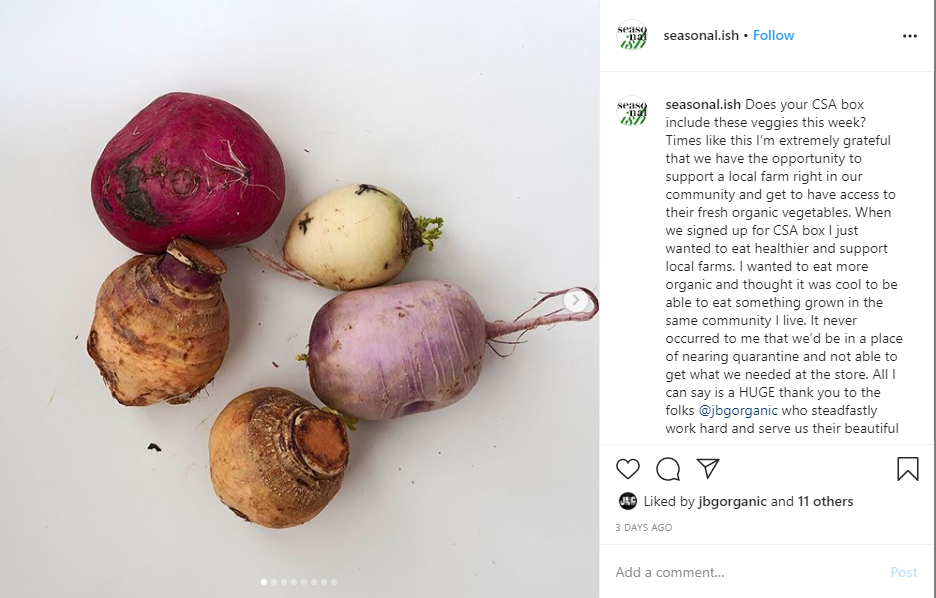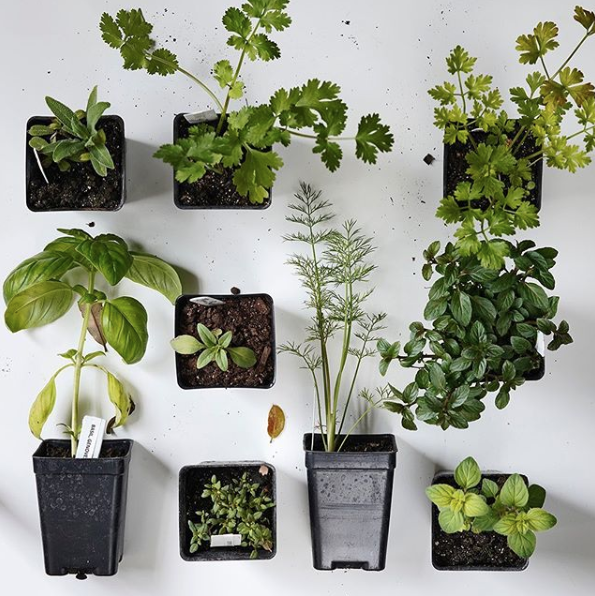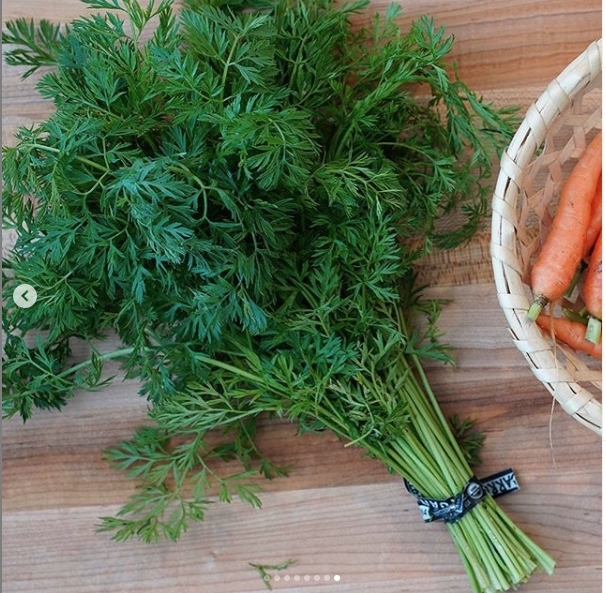
TALES OF A NEW CSA MEMBER: SOME CSA HACKS FROM ONE NEWBIE TO ANOTHER
03/27/20 — Ada Broussard
 Emily's meal planning setup. Photo courtesy of her Instagram, seasonal.ish.
Emily's meal planning setup. Photo courtesy of her Instagram, seasonal.ish.
By Emily Laughlin (follow for more @seasonal.ish)
If you are new to CSA or recently restarted an old subscription the circumstances that brought you here are different and let’s all just pause for a moment to contemplate what the farmers and operations staff have done for years and now in this extreme time to feed us all and keep us healthy. Let’s extend huge thanks and a collective round of applause to our local farmers and operations staff for the ongoing and hard work they do. Wow!
By the time we decided to try CSA I had already tried my hand at growing vegetables in the backyard (too many squirrels), attempted to start a community garden (too much politics), and attended some farm tours before finally realizing that my best role in this may just be consistently supporting others who do that work. Would simply supporting the work of others in food production make a bigger dent in my life and the lives of others in the community? For someone searching for greater connection to food production, and cleaner healthy eating CSA was POSSIBLY the answer.
Having no idea what they were going to send me, nor any idea how to deal with all those new-to-me-veggies and what was going to do with them(?), signing up for a CSA membership has turned out to be one of the best decisions and one way I actually ENJOY SPENDING money. As an investment it multiplies and returns back in great dividends such as: healthier appetite, chance for creativity in cooking, and a greater connection to local community.
At the beginning it was a little stressful. The first few weeks went like this: “what IS this??!!?!?!!?”, “how am i going to store all this?”, oh darn I forgot to EAT THAT (stares down browning broccoli)”, And so on....it felt like the clock was ticking and the pressure was on to make use of and all this food and do what one is supposed to do…um… what is one supposed to do with an entire cardboard box full of veggies?
 Photo courtesy of Emily's Instagram - seasnoal.ish.
Photo courtesy of Emily's Instagram - seasnoal.ish.
Your list of CSA hacks from one semi-newbie to another:
1. Storage & Prep Upon receiving the box, set time aside immediately to store it all the right way, right away. That means mindfully clearing space in fridge the day before delivery, keeping plastic storage bags on hand and reusing them over and over. Do a little research on which veggies need to be cut or kept as-is (hint: leave cabbage alone, cut off carrot tops but save them for the recipe below) and then research which ones go in the fridge vs. what goes on the counter top vs. dark pantry shelf. If it feels overwhelming check the farm website to preview what is coming in your box and read up on the storage tips on the site too!
2. A little planning goes a long way Don’t go to any food store in the days leading up to the day you get your veggie-box-o-love. With a little planning you’ll have a better idea how you’re going to use the veg and won’t end up with doubles or extras, effectively keeping your bills lower and getting only what you need. Again, preview the selection but also know amounts can differ slightly so you might get extra of one thing and less of another sometimes and know that is just the exciting realities of living directly off the land. However, if you follow the next tip you may not need to go to any food store after all.
3. Keep key ingredients on hand and you’ll be ready to cook most things a few different ways. I’m talking things like garlic, ginger, big yellow and red onions, basic dry noodles, some key oils and sauces (soy/tamarin/coconut aminos/, sesame oil, olive oil, balsamic vinegar, white vinegar), tahini (for veggie hummus), Parmesan, a semi-soft cheese, some proteins (chicken, beef, tofu, red beans, black beans, eggs), sea salt of course, and a few favorite fresh herbs. Or better yet…..
4. Start an herb garden in the kitchen window, pots outside, in the ground… wherever it works for you to get some good light, and remember to water it. There are lots of options. Rosemary tends to grow well here as a landscape shrub for example. JBG has a transplant sale you can buy starter plants and they frequently send out dill, cilantro or parsley in the boxes. So I recommend starting with basil, oregano, and thyme.
5. Quick Pickling Get a couple wide mouth mason jars and try your hand at being a pioneer. Hah, no we have refrigeration so it’s much easier. It’s cheap and fun and so satisfying to realize how resourceful you really are. You basically heat up some water, white vinegar, sugar, and salt then poor over sliced radish, cucumbers, carrots and you’ll have a great mix for tacos, sandwiches, etc... (see below for recipe ideas)
6. When in doubt just FREEZE When something appears to be wilting I just buckle up and make something with it and share it with a friend, or have as leftovers the next couple days. If you have a busy week ahead figure out how to combine it all into one dish, make a bunch of something and then freeze half (casserole, soup, quiche for example). If they send you lots of dill for example you can cut off little bits and freeze in bags or ice trays for later use! Since becoming a CSA member I’ve gained a small sense of what living at the mercy of the seasons, weather, and land provide and thought a lot more about my ancestors. Of course we aren’t doing the heavy lifting, and day to day operational planning that comes with farming so there’s that and we also have a huge leg up with refrigeration. So use it to your advantage! Quick pickling and cooking and freezing extends the life of not only your fresh veggies but also the good intentions you’ve made by committing to a few boxes of CSA membership. It doesn’t have to be perfect but try something new before you are forced to let it go into the compost pile. And that brings me to…
7. Composting - in some parts of the delivery zone there is city compost collection. But why would you allow all that primo organic waste go away to the city when you could gather it up and create the most amazing and free fertilizer for your own landscaping needs? This topic may be worthy of a whole other post but believe me if we can do it you can do it and it’s soooo much easier and more simple than some how-tos make it sound. I’ve even heard of apartment dwellers that do it successfully. Note: If you see Live Oaks nearby they are shedding ALL their many leaves RIGHT NOW so grab a couple bags full and you can start the compost of your dreams and have a place to send all your CSA peelings, trimmings and leftovers at the end of the day.
Earlier I touched on the subtle shift I’ve experienced since becoming a CSA member. When we receive our veggies I see a person in a delivery truck I know lives in the area, and that the veggies they bring were packed recently and nearby. I see the pictures on the blog of the people and even met a few who work to make that happen. I am familiar with the ground and soil that these veggies grew in and know first hand how hard it is to grow things in the hot Texas sun and where it seems we are either experiencing a flood or drought. I know the temps we’ve had because I’ve experienced them too. And with that comes a deep appreciation for the hard work and expertise it must take and I gladly support the effort, creativity, and organization it takes to run such an operation. Being a customer allows me a part of keeping this process going and a chance to belong to a greater local community. All this reminds me to minimize my waste and not take more than I need.
 Emily's transplants that she scooped up at the JBG Transplant sale and Club Home Made gardening workshop. Photo from Instagram.
Emily's transplants that she scooped up at the JBG Transplant sale and Club Home Made gardening workshop. Photo from Instagram.
If we can learn to accept what is natural and raw from the ground in the area we live we can support a process of natural organic food creation. Being a CSA member is for good health, and also supports a healthy local food system in our community and beyond. I’m contributing just one part of that process and every time I receive my box I’m reminded of my place in that system and that’s why it’s been a great decision to become a CSA member. So I thank and applaud you too for taking a chance, supporting local farmers, and our local community. If you are looking for ideas what to cook each week, want more tips and share ideas with people who are getting the same veggies that you are follow us on Instagram @seasonal.ish and say hi!
Carrot Top Pesto
As a pesto lover it blew my prepackaged-carrot-buying mind wide open when I realized one can make PESTO with green carrot tops!!!! If you already knew this don’t judge, but if you didn’t join me this week in collective resourcefulness and creativity in making this not so exotic but delightfully new treat. The main thing here is that a lot of substitutions work with this dish. Don’t have pine nuts? Use Walnuts. I’ve even seen ingredients with cashews and macadamia nuts in them. I’ve added in mozzarella when i didn’t have enough Parmesan for example. I just hope you have garlic and olive oil.
- Ingredients
- 1 bunch of carrot tops
- 1/2 cup Olive Oil
- 1/3 cup of pine nuts or walnuts (sub other nuts)
- 1/2 cup cheese (parmesan usually but I’ve subbed in mozzarella and it worked out)
- 2 garlic cloves
- 1/2 tsp salt & pepper
 Emily's carrot tops, ready for pesto. Photo from the seasonal.ish Instagram.
Emily's carrot tops, ready for pesto. Photo from the seasonal.ish Instagram.





 0 ITEMS IN CART
0 ITEMS IN CART 

